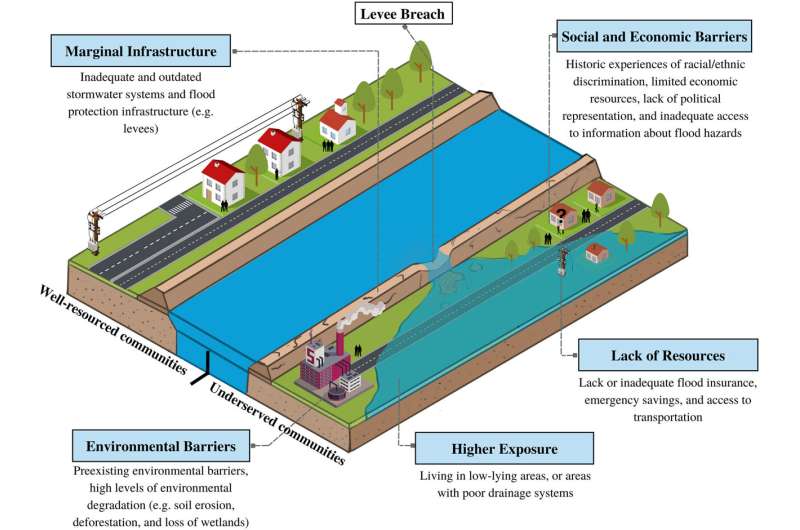This article has been reviewed according to Science X's editorial process and policies. Editors have highlighted the following attributes while ensuring the content's credibility:
fact-checked
peer-reviewed publication
trusted source
proofread
Disparities found in who dwells behind US levees

In the United States, tens of millions of people live behind levees, but historically disadvantaged groups are more likely to live behind subpar levees and have fewer resources to maintain critical levee infrastructure, a new study reveals. The study is the first to quantify the national disparity of disadvantaged communities living in levee-protected areas, which puts people at increased risk of flooding and other issues.
The United States is crosscut by several thousand miles of levees. Most are earthworks dating to the 18th and 19th centuries, when they were built to protect farmers' fields and small riverside communities. They were not designed or built to serve as critical infrastructure protecting millions of people 150 years later.
"The overall impact of a levee failure depends heavily on the community living behind the levee," said Farshid Vahedifard, a civil engineer at Tufts University who led the study.
"Levees are one of the most important examples of infrastructure inequity, which is a longstanding issue in our country. The recent infrastructure law shows there's consensus that we have to do something, but we need to have a better understanding of the problem before we can tackle it. This paper is a step toward that."
The study was published in Earth's Future, which publishes interdisciplinary research on the past, present and future of our planet and its inhabitants.
When properly maintained, levees essentially serve as built-up, armored riverbanks, protecting the area behind them from flooding. But when a levee is left to crumble, either because of a lack of resources or knowledge, it increases the community's risk of catastrophic levee failure and subsequent flooding. Most levees in the country today are in a state of disrepair and are approaching or at the end of their useful life, according to a 2021 assessment of levee infrastructure.
The 2022 Jobs Act set aside $1.2 billion for infrastructure with an emphasis on historically underserved or disadvantaged communities. A previous estimate suggested the U.S. needs to allocate approximately $27 billion over the next 10 years to bring the country's infrastructure up to acceptable standards before climate change is factored in.
"No matter how much funding we get, there's greater need," Vahedifard said. "That's the main reason we have to identify our priority areas, the places at the greatest risk."
To quantify disparities in who lives behind levees and highlight regions most in need of funds, Vahedifard analyzed census tract-level demographic data and levee information from the National Levee Database.
In census tracts around the country, areas behind levees have higher concentrations of people of Hispanic, Native American, Asian and Black backgrounds than areas not protected by levees, the study found. Hispanic people were the most overrepresented in levee-protected areas, with a 40% disparity nationwide. In the U.S. Midwest and Southeast, 60.6% and 40.2%, respectively, more Black populations live behind levees.
People with less education (particularly in the West) or lower wealth were also overrepresented in levee-protected areas.
In addition to individual factors such as race, wealth and education, the researchers analyzed the proportion of leveed versus non-leveed communities designated as "disadvantaged" based on the Climate and Economic Justice Screening Tool (CEJST). This tool identifies tracts nationwide where communities face significant burdens across various categories, including climate change, energy, health, housing, legacy pollution, transportation, water and wastewater, and workforce development. CEJST serves as a tool for federal agencies to identify disadvantaged communities to operationalize the White House's Justice40 program.
Communities classified as "disadvantaged" under CEJST are overrepresented behind levees in 43 states, with a national disparity percentage of 41%. The Northeast and West had the most unequal representation in leveed communities, with 57% and 51% overrepresentation of disadvantaged groups behind levees, respectively.
"We consistently saw an overrepresentation of disadvantaged or underserved communities living behind levees," said Vahedifard, who serves as the Resilient and Equitable Infrastructure Lead with the United Nations University Institute for Water, Environment and Health. "These people already face more barriers and limitations—less knowledge of risks and fewer resources to fix things—so it's a compounding issue."
Beyond allocating maintenance funds to communities in need and mapping uncounted levees, educating communities about levee condition and risk is a key next step, according to the authors.
"Public awareness and education are critical and inexpensive," Vahedifard said. "People need to know about the risks. And we need to have more transparency with these communities when it comes to data about the levees." Making information like that found in the National Levee Database more accessible—and comprehensible—to communities around the country.
"This is not a simple problem," Vahedifard said. "No matter how much money you have, you can't just say, 'Okay, now let's rebuild this.' The network is too extensive. But there are other ways we can reduce risk to these communities."
And that's only for the levees we know about. The National Levee Database may only capture about 25% of the country's levees, according to a recent study, and the Infrastructure Report Card estimated about an extra one-third of levees are of unknown location and condition. Advanced sensing technologies and remote sensing-based monitoring tools are coming, but are not widely deployed today, Vahedifard said.
"We definitely need to do more to improve our levee documentation and monitoring. That's critical," he said.
More information: Farshid Vahedifard et al, Overrepresentation of Historically Underserved and Socially Vulnerable Communities Behind Levees in the United States, Earth's Future (2023). DOI: 10.1029/2023EF003619
Journal information: Earth's Future
Provided by American Geophysical Union
This story is republished courtesy of Eos, hosted by the American Geophysical Union. Read the original story here.




















